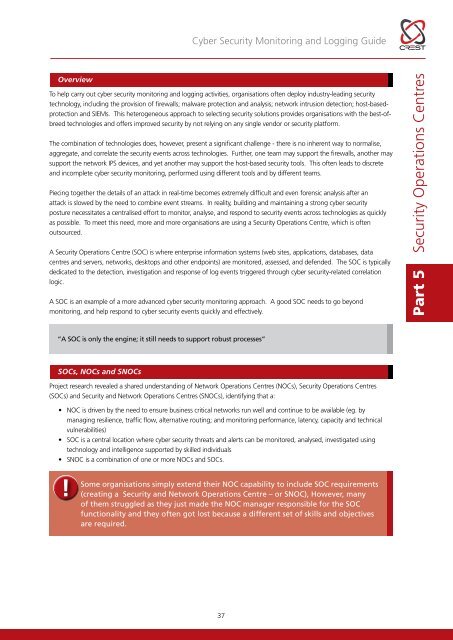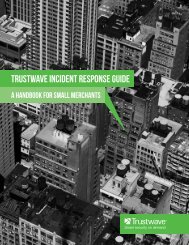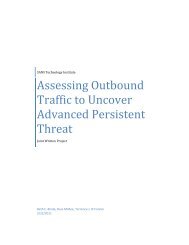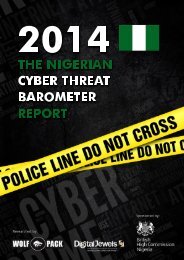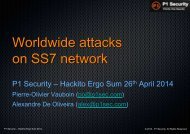Cyber-Security-Monitoring-Guide
Cyber-Security-Monitoring-Guide
Cyber-Security-Monitoring-Guide
Create successful ePaper yourself
Turn your PDF publications into a flip-book with our unique Google optimized e-Paper software.
<strong>Cyber</strong> <strong>Security</strong> <strong>Monitoring</strong> and Logging <strong>Guide</strong>OverviewTo help carry out cyber security monitoring and logging activities, organisations often deploy industry-leading securitytechnology, including the provision of firewalls; malware protection and analysis; network intrusion detection; host-basedprotectionand SIEMs. This heterogeneous approach to selecting security solutions provides organisations with the best-ofbreedtechnologies and offers improved security by not relying on any single vendor or security platform.The combination of technologies does, however, present a significant challenge - there is no inherent way to normalise,aggregate, and correlate the security events across technologies. Further, one team may support the firewalls, another maysupport the network IPS devices, and yet another may support the host-based security tools. This often leads to discreteand incomplete cyber security monitoring, performed using different tools and by different teams.Piecing together the details of an attack in real-time becomes extremely difficult and even forensic analysis after anattack is slowed by the need to combine event streams. In reality, building and maintaining a strong cyber securityposture necessitates a centralised effort to monitor, analyse, and respond to security events across technologies as quicklyas possible. To meet this need, more and more organisations are using a <strong>Security</strong> Operations Centre, which is oftenoutsourced.A <strong>Security</strong> Operations Centre (SOC) is where enterprise information systems (web sites, applications, databases, datacentres and servers, networks, desktops and other endpoints) are monitored, assessed, and defended. The SOC is typicallydedicated to the detection, investigation and response of log events triggered through cyber security-related correlationlogic.A SOC is an example of a more advanced cyber security monitoring approach. A good SOC needs to go beyondmonitoring, and help respond to cyber security events quickly and effectively.Part 5 <strong>Security</strong> Operations Centres“A SOC is only the engine; it still needs to support robust processes”SOCs, NOCs and SNOCsProject research revealed a shared understanding of Network Operations Centres (NOCs), <strong>Security</strong> Operations Centres(SOCs) and <strong>Security</strong> and Network Operations Centres (SNOCs), identifying that a:• NOC is driven by the need to ensure business critical networks run well and continue to be available (eg. bymanaging resilience, traffic flow, alternative routing; and monitoring performance, latency, capacity and technicalvulnerabilities)• SOC is a central location where cyber security threats and alerts can be monitored, analysed, investigated usingtechnology and intelligence supported by skilled individuals• SNOC is a combination of one or more NOCs and SOCs.!Some organisations simply extend their NOC capability to include SOC requirements(creating a <strong>Security</strong> and Network Operations Centre – or SNOC), However, manyof them struggled as they just made the NOC manager responsible for the SOCfunctionality and they often got lost because a different set of skills and objectivesare required.37


